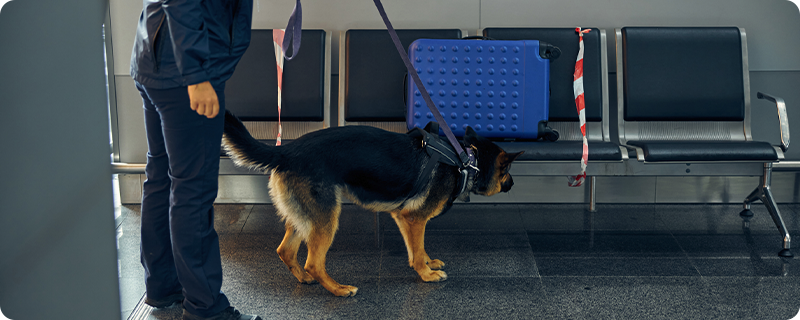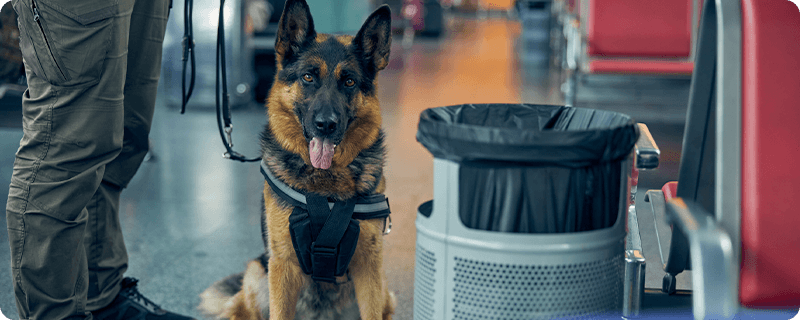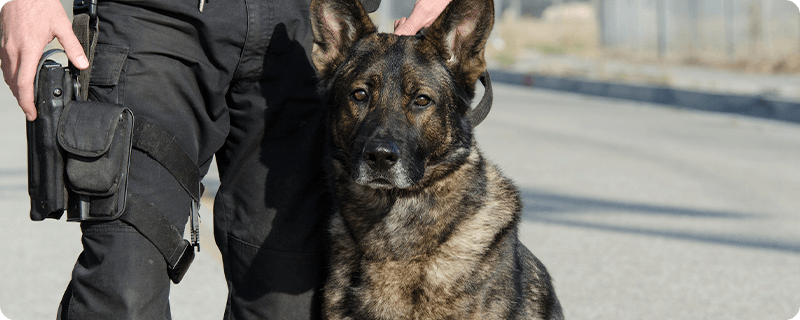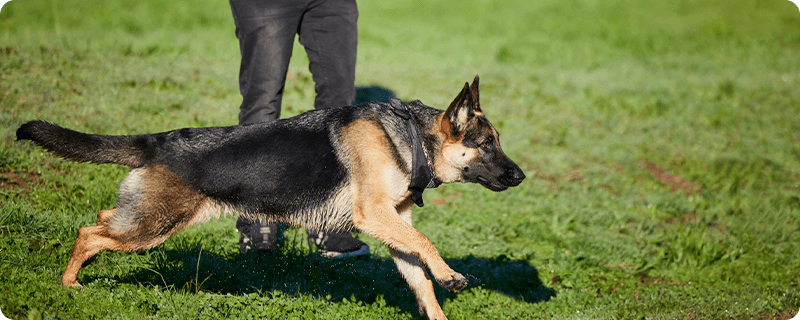Corporate Security: 5 Reasons to Include K9 Protection (Before It’s Too Late)

Canine security teams engage perpetrators immediately—while everyone is waiting for the police to arrive. This gives everyone a few extra seconds or even minutes to escape a dangerous situation.
Corporate Security: 5 Reasons to Include K9 Protection (Before It’s Too Late)
If numbers tell a story, then these violent workplace statistics tell a nightmare:
- The U.S. saw nearly six times as many active shooter incidents in 2014 and 2015 than it did in 2000 and 2001.
- 80+ percent of active shooter incidents occur in the workplace.
- Workplace violence injuries increased 23 percent in a single year.
Source
- The FBI’s “Study of Active Shooter Incidents in the United States Between 2000 and 2013” report shows that 160 active shooter incidents occurred in that 14-year period, resulting in 1,043 casualties – not including the shooters.
- Additionally, an average of 6.4 incidents happened each year in the first seven years of the study, and in the latter seven, an average of 16.4 incidents happened per year.
- OSHA’s website indicates that “[i]n 2011, U.S. hospitals recorded 253,700 work-related injuries and illnesses, a rate of 6.8 work-related injuries and illnesses for every 100 full-time employees. This is almost twice the rate for private industry as a whole.”
These statistics raise a critical question. How do we reduce—or better yet, prevent—these kinds of security threats from happening in the first place?
Deep vulnerability gaps in workplace security systems Corporate campuses and directors of corporate security face several key security vulnerabilities, including:
- Unprotected inside front entrances
- Unprotected outside campuses and parking lots
While these measures are worth pursuing, they still fall short of preventing severe threats from happening in the first place. The key question is this: how do we close these vulnerability gaps in a corporate environment?
Let’s look at the two main categories of threat prevention that are currently used:
- People
- Technology
1. People
How well-trained are the front guards? What will your front unarmed guards use to prevent a serious threat from happening?
· A laptop?
· A paper notebook?
· A coffee cup?
You see the point I’m making, right? An unarmed guard has little or no defensive tools to circumvent a serious threat
Are armed guards a better solution?
Let’s take a look. Armed guards have poor hit rates. Even if an armed guard could engage a threat, statistics show that a well-trained police officer has a 17%-43% hit rate. Can you imagine the poor hit rate of armed guards who don’t train nearly as much as professionally trained police officers?
According to Reveal News, “Men and women who have never fired a gun in their lives can set off on patrol in uniform, wearing a badge and carrying a loaded weapon, with only a few hours of training, if any. In 15 states, guards can openly carry guns on the job without any firearms training at all. The results can be as tragic as they are predictable.”
Additionally, global security company AFIMAC’s Robert D. Shuster states: “The average armed security officer does not have sufficient, or frequent enough, training to effectively engage a hostile shooter under the typical active shooter ‘combat’ conditions. Given current training standards, they might hurt an innocent bystander or co-worker, or get themselves killed. Mindset is also critical in this combat situation, and the armed security officer may not be able to muster the will to kill if necessary.”
2. Technology
Can the latest and best security technologies help reduce or prevent a severe threat?
While enhancing the speed and effectiveness of a response to a threat is the goal of any workplace prevention plan, the larger goal is to reduce (or ideally, prevent) that threat from happening in the first place. A June 1, 2018 Security Magazine article highlighted six technologies to help companies respond to active shooter situations:
1: Access control: limit access and movement to authorized persons
2: Video surveillance: maintain vigilance around the clock
3: Gunshot detection: detect an active shooter faster for a better response
4: Mass notification: inform and guide people with clarity
5: Smart building technology: coordinate systems in an emergency
6: Integration: bring it all together to respond better
While these technologies are helpful in identifying the perpetrators, do these technologies really help prevent a threat in the first place?
We’ve looked at how people and technology are used to minimize severe threats on corporate campuses. Now let’s look at one effective strategy often overlooked in preventing severe threats from happening in the first place: canine (K9) security. Why canines are effective in preventing threats Canines are a physical deterrent as much as they are a psychological deterrent to would-be criminals and disgruntled employees. Here’s the secret to why canines are so effective . The intruder becomes the prey (instead of the staff or employees becoming the prey). Canine security can replace traditional security measures and equipment, but it doesn’t have to; it can be used as an additional layer of security.
According to statistics on the National Center for Biotechnology Information website, canines have effectively reduced crime and violence by 75 to 80 percent in Midwest and East Coast hospitals where they’re used. And from the K9Fleck.org website, “a second study in Yarmouth, Massachusetts, showed a dramatic 80% decrease in commercial break-ins following the first year of a canine unit being on patrol and aggressively addressing the issue of the break-ins.”
Five reasons why corporate security directors should include K9 protection (before it’s too late)
Reason #1: Dogs are a visual deterrent
Often, just the presence of a dog can deter someone from acting unlawfully or dangerously. Dogs can deter aggressive behavior by their presence and their bark. They can even help maintain order and keep a friendly atmosphere during business hours and activities.
Reason #2: Speed of dogs
Canine security dogs can run up to 30 mph. Why is speed an important factor? The perpetrator is dealing with lots of psychological factors in the heat of the moment, a fast-moving dog is extremely difficult for a perpetrator to target accurately. Canines don’t have this psychological barrier.
Remember, the dog is naturally focused on anything or anyone moving.
For decades, dogs have been used in combat to help protect our military personnel in dangerous and life-threatening situations. In most cases, the dog will prevail; it’s in the dog’s DNA to accomplish its goal—to make sure it defeats the perpetrator.
Reason 3: One canine team = five armed security guards
One canine team (one canine plus one handler) can provide the same coverage as five security guards. That means one canine team can cover more ground and deter and apprehend the perpetrator (while being a visual deterrent for everyday security issues).
Reason 4: Canines are motivated to stop a threat
One of the unique aspects of security-trained canines is this simple idea: Canines don’t get psychologically confused like police or guards often do in life-threatening situations.
To a canine, a threat is a reward.
Officer Steven W. Sturm, a dog trainer with the Baltimore Police Department, says it best: “We see somebody with a gun or a weapon … we will get out of the way. … Dogs react totally the opposite. They go. No matter what they see, they’re going to be going unless we call them off.”
Reason 5: Time and distance = life-saving seconds
Since the perpetrator must deal with another equation, something coming after him, this gives people two great advantages:
- Time to leave the scene
- Distance between the active threat
Canine security teams engage perpetrators immediately—while everyone is waiting for the police to arrive. This gives everyone a few extra seconds or even minutes to escape a dangerous situation.
Summary
What happens when a perpetrator enters a corporate campus? As great as surveillance technologies are and as well-trained as people are, these systems offer only passive prevention capabilities. The missing ingredient in all these systems is active prevention.
That’s where canine (K9) security comes in . . . as an added layer of protection. Want to know more about K9 security for your corporation?
K9 X-Factor partners with hospitals, schools and corporations that are seeking an alternative approach to protecting their employees while reducing expensive liability issues related to having armed security guards.
K9 X-Factor is unique in that it supplies your business with “friendly first” dogs without sacrificing the safety of patients, students, or employees. Visit our website for more information or call Mark at 650-245-1644. Whether you want to buy a highly capable canine or lease a complete security canine team from K9 X-Factor, message me to learn whether a canine security team is right for you.
Join hundreds of security professionals, teachers, hospital and school administrators, nurses and corporate security directors to get the latest insights on
- K9 security trends
- K9 security reports
- Podcasts
- Ebooks
- Articles
Optional: Sign up for updates at the bottom of our home page.






